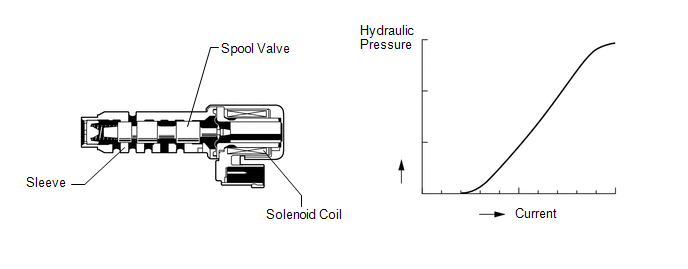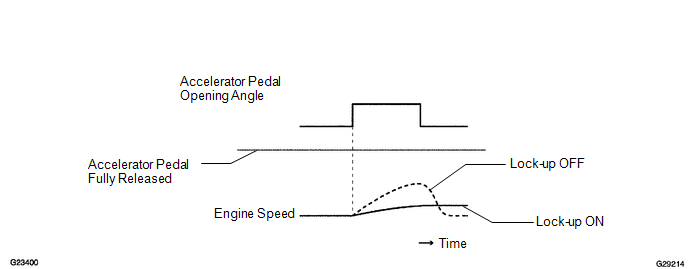Toyota Venza: Torque Converter Clutch Pressure Control Solenoid Performance (Shift Solenoid Valve SLU) (P2757)
SYSTEM DESCRIPTION
The TCM uses the signals from the throttle position sensor, air-flow meter, turbine (input) speed sensor, output speed sensor and crankshaft position sensor to monitor the engagement condition of the lock-up clutch.

The TCM compares the engagement condition of the lock-up clutch with the lock-up schedule in the TCM memory to detect shift solenoid valve SLU, valve body and torque converter mechanical problems.
|
DTC No. |
DTC Detection Condition |
Trouble Area |
|---|---|---|
|
P2757 |
When both of the following are detected (2-trip detection logic):
When both of the following are detected (2-trip detection logic):
|
|
MONITOR DESCRIPTION
Torque converter lock-up is controlled by the TCM based on the turbine (input) speed sensor NT, output speed sensor NC, engine rpm, engine load, engine temperature, vehicle speed, transmission fluid temperature, and gear selection. The TCM determines the lock-up status of the torque converter by comparing the engine rpm (NE) to the input turbine rpm (NT). The TCM calculates the actual transmission gear by comparing input turbine rpm (NT) to output shaft rpm (NC). When conditions are appropriate, the TCM requests "lock-up" by applying control voltage to shift solenoid SLU. When SLU is turned on, it applies pressure to the lock-up relay valve and locks the torque converter.
If the TCM detects no lock-up after lock-up has been requested or if it detects lock-up when it is not requested, the TCM interprets this as a fault in shift solenoid valve SLU or lock-up system performance.
The TCM will turn on the MIL and store the DTC.
Example:
When any of the following is met, the system judges it as a malfunction.
- There is a difference in rotation (speed) between the input side (engine
speed) and output side (input turbine speed) of the torque converter when
the TCM commands lock-up.
(Engine speed is at least 70 rpm greater than input turbine speed.)
- There is no difference in rotation (speed) between the input side (engine
speed) and output side (input turbine speed) of the torque converter when
the TCM commands lock-up off.
(The difference between engine speed and input turbine speed is less than 20 rpm.)
MONITOR STRATEGY
|
Related DTCs |
P2757: Shift solenoid valve SLU OFF malfunction Shift solenoid valve SLU ON malfunction |
|
Required sensors/Components |
Shift solenoid valve SLU |
|
Frequency of operation |
Continuous |
|
Duration |
OFF malfunction (a): 3.5 sec. OFF malfunction (b): 0.05 sec. ON malfunction (a): 1.8 sec. ON malfunction (b): 0.6 sec. |
|
MIL operation |
2 driving cycles |
|
Sequence of operation |
None |
TYPICAL ENABLING CONDITIONS
The following items are common to all conditions below.|
The monitor will run whenever this DTC is not present. (Not circuit malfunction) |
P0712, P0713 (ATF temperature sensor circuit (TFT sensor)) P0115, P0117, P0118 (ECT sensor circuit) P0715, P0717 (Turbine speed sensor circuit) P0791, P0793 (Intermediate shaft speed sensor circuit) P0748 (Shift solenoid valve SL1 circuit) P0778 (Shift solenoid valve SL2 circuit) P0798 (Shift solenoid valve SL3 circuit) P2810 (Shift solenoid valve SL4 circuit) P2759 (Shift solenoid valve SLU circuit) P2769, P2770 (Shift solenoid valve SL circuit) P0327, P0328, P0332, P0333 (KCS sensor circuit) P0120, P0121, P0122, P0123, P0220, P0222, P0223, P0604, P0606, P060A, P060B, P060D, P060E, P0657, P1607, P2102, P2103, P2111, P2112, P2118, P2119, P2135 ((ETCS) Electronic throttle control system) U0100 (CAN communication system) |
|
ECT (Engine coolant temperature) |
40°C (104°F) or more |
|
Spark advance from Max. retard timing by KCS control |
0°CA or more |
|
Transmission range |
"D" |
|
TFT (Transmission fluid temperature) |
-10°C (14°F) or more |
|
TFT (Transmission fluid temperature) sensor circuit |
No circuit malfunction |
|
ECT (Engine coolant temperature) sensor circuit |
No circuit malfunction |
|
Turbine speed sensor circuit |
No circuit malfunction |
|
Intermediate shaft speed sensor circuit |
No circuit malfunction |
|
Shift solenoid valve SL1 circuit |
No circuit malfunction |
|
Shift solenoid valve SL2 circuit |
No circuit malfunction |
|
Shift solenoid valve SL3 circuit |
No circuit malfunction |
|
Shift solenoid valve SL4 circuit |
No circuit malfunction |
|
Shift solenoid valve SLU circuit |
No circuit malfunction |
|
Shift solenoid valve SL circuit |
No circuit malfunction |
|
(KCS) Knock control sensor circuit |
No circuit malfunction |
|
(ETCS) Electronic throttle control system |
Not system down |
|
CAN communication system |
Not system down |
|
Engine |
Starting |
|
TCM selected gear |
Not 1st |
|
Vehicle speed |
15.5 mph (25 km/h) or more |
|
Turbine speed/Output speed (NT/NO) with 1st |
3.304 to 7.724 |
|
Turbine speed/Output speed (NT/NO) with 2nd |
1.901 to 2.340 |
|
Turbine speed/Output speed (NT/NO) with 3rd |
1.399 to 1.649 |
|
Turbine speed/Output speed (NT/NO) with 4th |
0.998 to 1.138 |
|
Turbine speed/Output speed (NT/NO) with 5th |
0.705 to 0.836 |
|
Turbine speed/Output speed (NT/NO) with 6th |
0.568 to 0.695 |
|
TCM lock-up command |
ON |
|
Duration time from lock-up on command |
3 sec. or more |
|
Shift solenoid valve SLU |
Not ON malfunction |
|
TCM lock-up command |
OFF |
|
Duration time from lock-up on command |
0.064 sec. or more |
|
Throttle valve opening angle |
7% or more |
|
Vehicle speed |
Less than 37.3 mph (60 km/h) |
|
Shift solenoid valve SLU |
Not malfunction |
|
Shift solenoid valve SL |
Not OFF malfunction |
TYPICAL MALFUNCTION THRESHOLDS
OFF malfunction:|
Following conditions are met |
(a) and (b) |
|
(a) Engine speed - Turbine speed |
70 rpm or more |
|
(b) Transmission fluid pressure switch |
OFF |
|
Following conditions are met |
(a) and (b) |
|
(a) Engine speed - Turbine speed |
Less than 35 rpm |
|
(b) Transmission fluid pressure switch |
ON |
COMPONENT OPERATING RANGE
|
Speed sensor (NT) |
Input speed is equal to engine speed when lock-up is ON. |
CAUTION / NOTICE / HINT
NOTICE:
Perform the universal trip to clear permanent DTCs (See page
.gif) ).
).
HINT:
Using the Techstream to perform Active Tests allows relays, VSVs, actuators and other items to be operated without removing any parts. This non-intrusive functional inspection can be very useful because intermittent operation may be discovered before parts or wiring is disturbed. Performing Active Tests early in troubleshooting is one way to save diagnostic time. Data List information can be displayed while performing Active Tests.
1. ACTIVE TEST
(a) Warm up the engine.
(b) Turn the ignition switch off.
(c) Connect the Techstream to the DLC3.
(d) Turn the ignition switch to ON.
(e) Turn the Techstream on.
(f) Enter the following menus: Powertrain / ECT / Active Test.
(g) According to the display on the Techstream, perform the Active Test.
|
Tester Display |
Test Part |
Control Range |
Diagnostic Note |
|---|---|---|---|
|
Activate the Lock Up |
[Test Details] Control the shift solenoid SLU and SL to set the automatic transaxle to the lock-up condition. [Vehicle Condition]
|
[Lock-up] 0: OFF 1: ON |
Can be used to check SLU and SL solenoid operation. |
HINT:
- This test can be conducted when the vehicle speed is 60 km/h (37 mph) or more.
(h) Lightly depress the accelerator pedal and check that the engine speed does not change abruptly.
HINT:
- When changing the accelerator pedal opening angle while driving, if the engine speed does not change, lock-up is on.
- Slowly release, but not fully, the accelerator pedal in order to decelerate. (Fully releasing the pedal will close the throttle valve and lock-up may be turned off.)

PROCEDURE
|
1. |
CHECK OTHER DTCS OUTPUT (IN ADDITION TO DTC P2757) |
(a) Connect the Techstream to the DLC3.
(b) Turn the ignition switch to ON.
(c) Turn the Techstream on.
(d) Enter the following menus: Powertrain / ECT / Trouble Codes.
(e) Read the DTCs using the Techstream.
|
Display (DTC output) |
Proceed to |
|---|---|
|
Only "P2757" is output |
A |
|
"P2757" and other DTCs are output |
B |
HINT:
If any other codes besides "P2757" are output, perform troubleshooting for those DTCs first.
| B | .gif) |
GO TO DTC CHART |
|
|
2. |
INSPECT SHIFT SOLENOID VALVE SLU |
|
(a) Remove shift solenoid valve SLU. |
|
(b) Measure the resistance according to the value(s) in the table below.
Standard Resistance:
|
Tester Connection |
Condition |
Specified Condition |
|---|---|---|
|
1 - 2 |
20°C (68°F) |
5.0 to 5.6 Ω |
|
*1 |
Shift Solenoid Valve SLU |
(c) Connect a battery positive (+) lead with a 21 W bulb to terminal 2 and a negative (-) lead to terminal 1 of the solenoid valve connector. Then check that the valve moves and makes an operating sound.
OK:
Valve moves and makes an operating sound.
| NG | .gif) |
REPLACE SHIFT SOLENOID VALVE SLU |
|
|
3. |
INSPECT TRANSMISSION VALVE BODY ASSEMBLY |
(a) Check the transmission valve body assembly (See page
.gif) ).
).
OK:
There are no foreign objects on each valve and they operate smoothly.
| NG | .gif) |
REPLACE TRANSMISSION VALVE BODY ASSEMBLY |
|
|
4. |
INSPECT TORQUE CONVERTER ASSEMBLY |
(a) Check the torque converter assembly (See page
.gif) ).
).
OK:
The torque converter operates normally.
| OK | .gif) |
REPLACE AUTOMATIC TRANSMISSION ASSEMBLY |
| NG | .gif) |
REPLACE TORQUE CONVERTER ASSEMBLY |
 Pressure Control Solenoid "D" Electrical (Shift Solenoid Valve SLT) (P2716)
Pressure Control Solenoid "D" Electrical (Shift Solenoid Valve SLT) (P2716)
DESCRIPTION
Refer to DTC P2714 (See page ).
DTC No.
DTC Detection Condition
Trouble Area
P2716
Open or short is detected in shift soleno ...
 Pressure Control Solenoid "D" Performance (Shift Solenoid Valve SLT) (P2714)
Pressure Control Solenoid "D" Performance (Shift Solenoid Valve SLT) (P2714)
SYSTEM DESCRIPTION
The linear solenoid valve (SLT) controls the transmission line pressure for smooth
transmission operation based on signals from the throttle position sensor and the
vehicle spe ...
Other materials about Toyota Venza:
Open in Front Passenger Side Electrical Antenna Circuit (B27A2)
DESCRIPTION
The certification ECU (smart key ECU assembly) generates a request signal and
sends it to the door electrical key oscillator built into the front door outside
handle assembly (for front passenger side) at 0.25-second intervals. To detect a
k ...
Problem Symptoms Table
PROBLEM SYMPTOMS TABLE
HINT:
Use the table below to help determine the cause of the problem symptoms. If multiple
suspected areas are listed, the potential causes of the symptoms are listed in order
of probability in the "Suspected Area" column ...
Inspection
INSPECTION
PROCEDURE
1. INSPECT REAR POWER WINDOW REGULATOR MOTOR ASSEMBLY LH
(a) Apply positive (+) battery voltage to connector terminal 2 (B).
NOTICE:
Do not apply positive (+) battery voltage to any terminals other than
terminal 2 ( ...
0.1491

.gif)
.png)